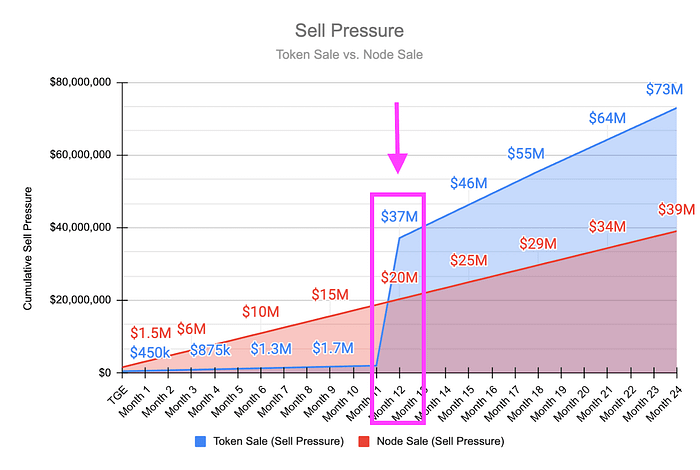CT.COM and Node Sales pt.1
Why did the Node Sales model become popular and what problems does it solve?
The problem at hand
Today in web3 and elsewhere, financial capital follows social capital. We increasingly rely on social capital deployed by brands, influencers, and other perceived authorities to proxy value. Funds are raised through an intricate social network. The Project’s reputation is frequently proxied by influencers that promote it. The downsides of this increasingly attention-centric economy are many and varied, but all have to do with the ultimate distortions in how value is allocated:
Misallocation of Value: Genuine contributors often receive the same deals as those with fake audiences, leading to misallocation of value. Communities of retail investors frequently serve as nothing more than exit liquidity due to asymmetric information — a classic lemon problem from Economics 101.
Costly Engagement Tracking: Tracking engagement is operationally expensive and susceptible to increasingly more inventive Sybil attacks. Airdrop meta is not bringing as much value as it used to, while the campaigns became largely commoditized: today strong liquidity outflows typically follow the eventual airdrop distribution.
Opaque Deals: absent a strong lead investor, pre-public funding rounds are opaque and frequently circumstantial, frequently exacerbating the value as mentioned earlier misallocation.
What is CT.COM?
CT.com is a primary market infrastructure designed to solve these issues, featuring:
1. Industry’s leading partners, such as Galactica.com, Zama, and Nebula
2. Seamless UX integrated directly into a vibrant and rapidly growing telegram ecosystem (as well as many others), and
3. State-of-the-art Web3 Identity Stack for privacy powered by FHE-focused Galactica.com and Zama technologies.
CT.com matches Fully Diluted Valuations (FDVs) and allocation sizes with user Reputation points, which proxy contributions, thus, merit and not simply financial capital as is frequently the case in primary markets today. This ensures that users can earn their way to be at par with larger players in the space, such as VCs and others with advanced access to projects.
What’s a Node Sale?
Typically, a node sale is a form of capital raise where buyers purchase the right (or license) to operate a node within a network, rather than a typical token sale where buyers directly purchase a token with a vesting schedule. More generally, purchasing a node license is equivalent to acquiring a “permit” to perform work and getting inflation rewards in return. The definition of ‘work’ is largely up to the project to define in line with the incentives the project wants to create and can constitute anything from technical work, like running a validator to social work like creating and distributing content, and anything in between.
Usually, these nodes are purchased as an NFT with a lockup period or an SBT.
A node sale should result in a more meritocratic capital distribution — a hybrid between a VC funding model and an airdrop. In such a model, the user’s effective vesting schedule would dynamically adjust reflecting the quality of work being performed.
Nodes perform tasks for the network in exchange for rewards:
Based on X% of the supply allocated for node rewards by the project.
Additional allocation in the form of a vested airdrop.
Structure of a Node Sale:
A user is offered to buy a whitelist spot to deploy ‘a validator’ that has a claim on a % of ecosystem token supply over its lifetime;
For example, if there are 100 tokens of inflation distributed over a year and there are 100 nodes that are sold, every such node will have on average 1 token accruing to it over 1 year;
Every node has a dollar price that translates into an implied FDV of the protocol;
Typically, nodes are tranched into tiers, every tier having the following parameters:
A node price (strictly increasing);
Number of nodes offered; A partner allocation — nodes reserved for partners;
An FCFS allocation — number of nodes less partner allocation;
A referral % — percent accruing to a referee that the referee can decide to return to a purchaser as a cashback, effectively decreasing the node price;
There is competition for the best referral links and partner allocations in the earlier tiers — those with a better price.
Usually, Node Sales happen on launchpads like Swissborg Alpha / own project website through a white-labeled platform.
Why did Node Sales become popular?
The popularity of node sales can be attributed to several factors. They gained traction partly due to potential regulatory advantages, as they navigate securities regulations more easily than traditional token offerings. The concept spread rapidly through Web3 communities due to its novel approach and the potential for high returns. Unicorns like Aethir and Sophon attracted a lot of attention not only to themselves but to the concept of node sales as well.
Perhaps most appealingly, node sales promise financial benefits for all participants — node operators earn rewards with the possibility of selling these nodes after a certain time, projects secure funding and network support, and for market participants these tokens might seem “safer” assets due to smooth injections into circulating supply and less selling pressure compared to classic token sale.
A key factor in the popularity of node sales is the alignment of incentives among stakeholders. Project developers secure funding and build a network of committed operators. Node operators gain early access to potentially profitable network participation. Token holders benefit from a more stable and secure network. The overall ecosystem enjoys faster growth, enhanced security, and increased decentralization.
To be continued…
Sources
[1] Node Sales Explained: A Beginner’s Guide, blocktech



